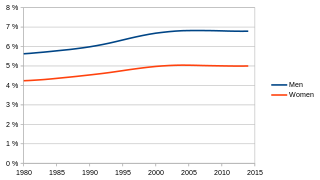Related Research Articles

Metabolic syndrome is a clustering of at least three of the following five medical conditions: abdominal obesity, high blood pressure, high blood sugar, high serum triglycerides, and low serum high-density lipoprotein (HDL).

Obesity is a medical condition, sometimes considered a disease, in which excess body fat has accumulated to such an extent that it can potentially have negative effects on health. People are classified as obese when their body mass index (BMI)—a person's weight divided by the square of the person's height—is over 30 kg/m2; the range 25–30 kg/m2 is defined as overweight. Some East Asian countries use lower values to calculate obesity. Obesity is a major cause of disability and is correlated with various diseases and conditions, particularly cardiovascular diseases, type 2 diabetes, obstructive sleep apnea, certain types of cancer, and osteoarthritis.

Lifestyle diseases can be defined as the diseases linked to the manner in which a person lives their life. These diseases are non-communicable, and can be caused by lack of physical activity, unhealthy eating, alcohol, substance use disorders and smoking tobacco, which can lead to heart disease, stroke, obesity, type II diabetes and lung cancer. The diseases that appear to increase in frequency as countries become more industrialized and people live longer include Alzheimer's disease, arthritis, atherosclerosis, asthma, cancer, chronic liver disease or cirrhosis, chronic obstructive pulmonary disease, colitis, irritable bowel syndrome, type 2 diabetes, heart disease, hypertension, metabolic syndrome, chronic kidney failure, osteoporosis, PCOD, stroke, depression, obesity and vascular dementia.
Essential hypertension is a form of hypertension without an identifiable physiologic cause. It is the most common type affecting 85% of those with high blood pressure. The remaining 15% is accounted for by various causes of secondary hypertension. Essential hypertension tends to be familial and is likely to be the consequence of an interaction between environmental and genetic factors. Hypertension can increase the risk of cerebral, cardiac, and renal events.

Weight gain is an increase in body weight. This can involve an increase in muscle mass, fat deposits, excess fluids such as water or other factors. Weight gain can be a symptom of a serious medical condition.

Diseases of affluence, previously called diseases of rich people, is a term sometimes given to selected diseases and other health conditions which are commonly thought to be a result of increasing wealth in a society. Also referred to as the "Western disease" paradigm, these diseases are in contrast to "diseases of poverty", which largely result from and contribute to human impoverishment. These diseases of affluence have vastly increased in prevalence since the end of World War II.

Hyperinsulinemia is a condition in which there are excess levels of insulin circulating in the blood relative to the level of glucose. While it is often mistaken for diabetes or hyperglycaemia, hyperinsulinemia can result from a variety of metabolic diseases and conditions, as well as non-nutritive sugars in the diet. While hyperinsulinemia is often seen in people with early stage type 2 diabetes mellitus, it is not the cause of the condition and is only one symptom of the disease. Type 1 diabetes only occurs when pancreatic beta-cell function is impaired. Hyperinsulinemia can be seen in a variety of conditions including diabetes mellitus type 2, in neonates and in drug-induced hyperinsulinemia. It can also occur in congenital hyperinsulinism, including nesidioblastosis.
Nutritional genomics, also known as nutrigenomics, is a science studying the relationship between human genome, human nutrition and health. People in the field work toward developing an understanding of how the whole body responds to a food via systems biology, as well as single gene/single food compound relationships. Nutritional genomics or Nutrigenomics is the relation between food and inherited genes, it was first expressed in 2001.

The Western pattern diet is a modern dietary pattern that is generally characterized by high intakes of pre-packaged foods, refined grains, red meat, processed meat, high-sugar drinks, candy and sweets, fried foods, industrially produced animal products, butter and other high-fat dairy products, eggs, potatoes, corn, and low intakes of fruits, vegetables, whole grains, pasture-raised animal products, fish, nuts, and seeds.
The diet-induced obesity model is an animal model used to study obesity using animals that have obesity caused by being fed high-fat or high-density diets. It is intended to mimic the most common cause of obesity in humans. Typically mice, rats, dogs, or non-human primates are used in these models. These animals can then be used to study in vivo obesity, obesity's comorbidities, and other related diseases. Users of such models must take into account the duration and type of diet as well as the environmental conditions and age of the animals, as each may promote different bodyweights, fat percentages, or behaviors.
The Baker Heart and Diabetes Institute, commonly known as the Baker Institute, is an Australian independent medical research institute headquartered in Melbourne, Victoria. Established in 1926, the institute is one of Australia's oldest medical research organisations with a historical focus on cardiovascular disease. In 2008, it became the country's first medical research institute to target diabetes, heart disease, obesity and their complications at the basic, clinical and population health levels.

According to 2007 statistics from the World Health Organization (WHO), Australia has the third-highest prevalence of overweight adults in the English-speaking world. Obesity in Australia is an "epidemic" with "increasing frequency." The Medical Journal of Australia found that obesity in Australia more than doubled in the two decades preceding 2003, and the unprecedented rise in obesity has been compared to the same health crisis in America. The rise in obesity has been attributed to poor eating habits in the country closely related to the availability of fast food since the 1970s, sedentary lifestyles and a decrease in the labour workforce.

Weight management refers to behaviors, techniques, and physiological processes that contribute to a person's ability to attain and maintain a healthy weight. Most weight management techniques encompass long-term lifestyle strategies that promote healthy eating and daily physical activity. Moreover, weight management involves developing meaningful ways to track weight over time and to identify the ideal body weights for different individuals.

Obesity in the Middle East and North Africa is a notable health issue. Out of the 15 fattest nations in the world as of 2014, according to the World Health Organization (WHO), five were located in the Middle East and North Africa region.

An estimated 275 Australians develop diabetes every day. The 2005 Australian AusDiab Follow-up Study showed that 1.7 million Australians have diabetes but that up to half of the cases of type 2 diabetes remain undiagnosed.
Obesity in Pakistan is a health issue that has effected concern only in the past few years. Urbanisation, fast food, changing lifestyles and the fact that traditional Pakistani Cuisine tends to be high in fat and sugar are among the root causes contributing to obesity in the country. Pakistan is ranked 165 in terms of its overweight population, with 8.2% of individuals over the age of 15 crossing the threshold of obesity. This ratio roughly corresponds with other studies, which state one-in-five Pakistani adults as being overweight. In Pakistan, the problem of excess weight is quite high among adults.
This article provides a global overview of the current trends and distribution of metabolic syndrome. Metabolic syndrome refers to a cluster of related risk factors for cardiovascular disease that includes abdominal obesity, diabetes, hypertension, and elevated cholesterol.

Preventive Nutrition is a branch of nutrition science with the goal of preventing, delaying, and/or reducing the impacts of disease and disease-related complications. It is concerned with a high level of personal well-being, disease prevention, and diagnosis of recurring health problems or symptoms of discomfort which are often precursors to health issues. The overweight and obese population numbers have increased over the last 40 years and numerous chronic diseases are associated with obesity. Preventive nutrition may assist in prolonging the onset of non-communicable diseases and may allow adults to experience more "healthy living years." There are various ways of educating the public about preventive nutrition. Information regarding preventive nutrition is often communicated through public health forums, government programs and policies, or nutritional education. For example, in the United States, preventive nutrition is taught to the public through the use of the food pyramid or MyPlate initiatives.

Soul food is a kind of African American cuisine that encompasses a variety of fried, roasted, and boiled food dishes consisting of chicken and pork meats, sweet potatoes, corn, leafy greens and other vegetables. Soul food has long been embedded in African American culture, but pushes towards healthy eating habits, for both physical and mental health, have adapted soul food cuisine to fit within health trends. This article will describe modifications of traditional soul food within health trends, including soul food with low carb, soul food with low sugar, soul food with low fat, soul food for vegan and soul food in gluten-free.

Cuilin Zhang is a Chinese-American epidemiologist and physician-scientist researching the roles of genetic and environmental factors in the pathogenesis of gestational diabetes, type 2 diabetes, and obesity and health consequences of these complications. Zhang is a senior investigator and acting chief of the epidemiology branch at the Eunice Kennedy Shriver National Institute of Child Health and Human Development.
References
- ↑ Gracey, Michael (1995). "New World syndrome in Western Australian aborigines". Clinical and Experimental Pharmacology and Physiology. 22 (3): 220–225. doi:10.1111/j.1440-1681.1995.tb01985.x. ISSN 0305-1870. PMID 7554419. S2CID 27870339. Archived from the original on 2013-01-05.
- ↑ Shell, Ellen Ruppel (2001). "New World Syndrome - Spam and turkey tails have turned Micronesians into Macronesians. A case study of how fatty Western plenty is taking a disastrous toll on people in developing countries". The Atlantic. 50. ISSN 1072-7825.
- ↑ Lambert, Lorelei (1999). "The Kerr Dam: Collisions of Cultures". Keepers of the Central Fire: Issues in Ecology for Indigenous Peoples. Sudbury, MA: Jones & Bartlett Publishers. p. 46. ISBN 9780763709235. OCLC 44955349.
With the expansion of the dominant culture, the people of the Flathead Nation grew increasingly dependent on a cash economy, and the dietary and health changes that resulted from an increase of carbohydrates in the diet. Today, diabetes, cardiac problems, hypertension, and the plethora of disease caused by obesity plague many members of the Flathead Nation (Personal conversation with Roy Big Crane).